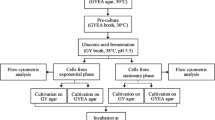Abstract
Veillonella parvula strain 259 (=DSM 2007) was able to grow on a mineral salts medium supplemented with (per litre) 1 g yeast extract, 1 g Tween-80, and 3 mg putrescine. 2 HCl, with 6 mM thioglycolate as reductant and lactate as growth substrate. Succinate did not serve as a growth substrate, but when added in conjunction with lactate, it was decarboxylated to propionate and resulted in a measurable increase in growth yield, corresponding to the formation of 2.4 g cell dry mass per mol succinate. A growth yield increase linked to succinate metabolism occurred only while lactate was also being metabolised. Experiments with cell suspensions showed that succinate decarboxylating activity was constitutive. Addition of succinate produced clear increases in cellular ATP levels in ATP-depleted washed cells.
Similar content being viewed by others
Abbreviations
- MOPS:
-
3-(N-morpholino) propanesulfonic acid
References
Blaut M, Gottschalk G (1984) Coupling of ATP synthesis and methane formation from methanol and molecular hydrogen in Methanosarcina barkeri. Eur J Biochem 141: 217–222
Breznak JA, Switzer JM, Seitz HJ (1988) Sporomusa termitida sp. nov., an H2/CO2-utilizing acetogen isolated from termites. Arch Microbiol. 150: 282–288
Brulla WJ, Bryant MP (1989) Growth of the syntrophic acetogen, strain PA-1, with glucose or succinate as energy source. Appl Environ Microbiol 55: 1289–1290
Dehning I, Stieb M, Schink B (1989) Sporomusa malonica sp. nov., a homoacetogenic bacterium growing by decarboxylation of malonate or succinate. Arch Microbiol 151: 421–426
Denger K, Schink B (1990) New motile anaerobic bacteria growing by succinate decarboxylation to propionate. Arch Microbiol 154: 550–555
Deutsche Sammlung von Mikroorganismen (1989) Catalogue of strains, 4th edn. GBF, Braunschweig, FRG
deVries W, Rietveld-Struijk RM, Stouthamer AH (1977) ATP formation associated with fumarate and nitrate reduction in growing cultures of Veillonella alcalescens. Antonie van Leeu-wenhoek J Microbiol Serol 43: 153–167
Galivan JH, Allen SHJ (1968) Methylmalonyl coenzyme A decarboxylase. Its role in succinate decarboxylation by Micrococcus lactilyticus. J Biol Chem 243: 1253–1261
Hamilton WA (1988) Energy-transduction in anaerobic bacteria. In: Anthony A (ed) Bacterial energy transduction. Academic Press, London, pp. 83–149
Hilpert W, Dimroth P (1982) Conversion of the chemical energy of methylmalonyl-CoA decarboxylation into a Na+ gradient. Nature 296: 584–585
Hilpert W, Dimroth P (1983) Purification and characterization of a new sodium-transport decarboxylase. Methlmalonyl-CoA decarboxylase from Veillonella alcalescens. Eur J Biochem 132: 579–587
Hilpert W, Dimroth P (1991) On the mechanism of sodium ion translocation by methylmalonyl-CoA decarboxylase from Veillonella alcalescens. Eur J Biochem 195: 79–86
Hilpert W, Schink B, Dimroth P (1984) Life by a new decarboxylation-dependent energy conservation mechanism with Na+ as coupling ion. EMBO J 3: 1665–1670
Janssen PH (1990) Fermentation of glycollate by a mixed culture of anaerobic bacteria. Syst Appl Microbiol 13: 327–332
Janssen PH (1991) Characterization of a succinate-fermenting anaerobic bacterium isolated from a glycolate-degrading mixed culture. Arch Microbiol 155: 288–293
Janssen PH, Harfoot CG (1990a) Ilyobacter delafieldii sp. nov., a metabolically restricted anaerobic bacterium fermenting PHB. Arch Microbiol 154: 253–259
Janssen PH, Harfoot CG (1990b) Isolation of a Citrobacter species able to grow on malonate under strictly anaerobic conditions. J Gen Microbiol 136: 1037–1042
Laubinger W, Dimroth P (1989) The sodium ion translocating adenosinetriphosphatase of Propionigenium modestum pumps protons at low sodium ion concentrations. Biochemistry 28: 7194–7198
Lundin A, Thore A (1975) Analytical information obtainable by evaluation of the time course of firefly bioluminescence in the assay of ATP. Anal Biochem 66: 47–63
Ng SKC, Hamilton IR (1971) Lactate metabolism by Veillonella parvula. J Bacteriol 105: 999–1005
Olliver B, Cord-Ruwisch R, Lombardo A, Garcia JL (1985) Isolation and characterization of Sporomusa acidovorans sp. nov., a methylotrophic homoacetogenic bacterium. Arch Microbiol 142: 307–310
Patel BKC, Monk C, Littleworth H, Morgan HW, Daniel RM (1987) Clostridium fervidus sp. nov., a new chemoorganotrophic acetogenic thermophile. Int J Syst Bacteriol 37: 123–126
Rogosa M, Bishop FS (1964) The genus Veillonella. II. Nutritional studies. J. Bacteriol 87: 574–580
Schink B (1990) Conservation of small amounts of energy in fermenting bacteria. In: Finn RK, Präve P (eds) Biotechnology focus 2. Hanser Publishers, Munich, pp. 63–89
Schink B, Pfennig N (1982) Propionigenium modestum gen. nov., sp. nov. a new strictly anaerobic, nonsporing bacterium growing on succinate. Arch Microbiol 133: 209–216
Stouthamer AH, (1979) The search for correlation between theoretical and experimental growth yields. In: Quayle JR (ed) International review of biochemistry, vol 21. Microbial biochemistry. University Park Press, Baltimore, pp. 1–47
Tanaka B, Nakamura K, Mikami K (1990) Fermentation of maleate by a Gram-negative strictly anaerobic non-sporeformer, Propionivibrio dicarboxylicus gen. nov., sp. nov. Arch Microbiol. 154: 323–328
Thauer RK, Jungermann K, Decker K (1977) Energy conservation in chemotrophic anaerobic bacteria. Bacteriol Rev 41: 100–180
Yousten AA, Delwiche EA (1961) Biotin and vitamin B12 coenzymes in succinate decarboxylation by Propionibacterium pentosaceum and Veillonella alcalescens. Bacteriol Proc 61: 175
Author information
Authors and Affiliations
Rights and permissions
About this article
Cite this article
Janssen, P.H. Growth yield increase and ATP formation linked to succinate decarboxylation in Veillonella parvula . Arch. Microbiol. 157, 442–445 (1992). https://doi.org/10.1007/BF00249102
Received:
Accepted:
Issue Date:
DOI: https://doi.org/10.1007/BF00249102




